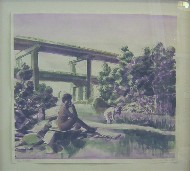 Edward M. Epstein’s pen and wash “Delaware Vistas, Condensed” show at aSFe (art studio for experiments) have the look of the British tradition of travelog paintings mixed with politics, in this case the commentary being the loss of uninterrupted, unpolluted natural views. The work instantly brought to mind Steve Mumford’s “Baghdad Journal,” which ran in artnet.com.
Edward M. Epstein’s pen and wash “Delaware Vistas, Condensed” show at aSFe (art studio for experiments) have the look of the British tradition of travelog paintings mixed with politics, in this case the commentary being the loss of uninterrupted, unpolluted natural views. The work instantly brought to mind Steve Mumford’s “Baghdad Journal,” which ran in artnet.com.
I get the sense that Epstein’s vistas are composites of the Delaware Valley landscape, given the poses of the nudes appropriated from Renoir (see top image), the old-fashioned sailing ship behind the hamburger joint (image left), and the miles of what look like slag heaps.
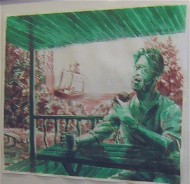 But the paintings have the charm of a slice of modern life with young people chatting on a deck in a vast, mountainous landscape–very romantic until you note the towering oil tanks rising to the clouds atop the mountains like giant space ships grown to a size beyond all rational proportion.
But the paintings have the charm of a slice of modern life with young people chatting on a deck in a vast, mountainous landscape–very romantic until you note the towering oil tanks rising to the clouds atop the mountains like giant space ships grown to a size beyond all rational proportion.
I especially liked the drawings with the high contrast and the more improbable, shocking second colors–green, purple. They seemed like a new wrinkle on an old genre.
Epstein directs the 40th Street Artist-in-Residence program, located in West Philadelphia, which grants free studio space to neighborhood artists on a six-month rotating basis.
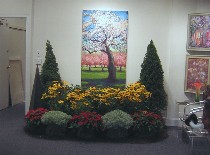 A few doors away from aSFe, Sande Webster Gallery has gone all out with mad plantings in the gallery itself for the show ” The Garden is Art, Art of the Garden” (right, one of the indoor islands of live flowers and greenery, with David Wander’s oil “Cherry White” in the background and to the right of the plantings, Andrew Turner’s acrylic “Three Vases” above and James Atkins’ oil “Warm Flowers” below.
A few doors away from aSFe, Sande Webster Gallery has gone all out with mad plantings in the gallery itself for the show ” The Garden is Art, Art of the Garden” (right, one of the indoor islands of live flowers and greenery, with David Wander’s oil “Cherry White” in the background and to the right of the plantings, Andrew Turner’s acrylic “Three Vases” above and James Atkins’ oil “Warm Flowers” below.
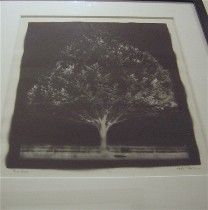 But the work I liked best in this show were the photographs from Ron Tarver and from Andrea Baldeck, both bodies of work luminous and magical, but not wholly unexpected. I thought it ironic that some of the best paintings and drawings in the show were in the hallway (left, Tarver’s “Big Tree”).
But the work I liked best in this show were the photographs from Ron Tarver and from Andrea Baldeck, both bodies of work luminous and magical, but not wholly unexpected. I thought it ironic that some of the best paintings and drawings in the show were in the hallway (left, Tarver’s “Big Tree”).
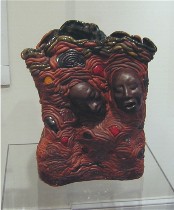 In typical Webster Gallery fashion, lots of other stuff was compressed into the back space–sculptures, benches, tables. Amongst it was this rather amazing face vase by Gary Camp (right), all hand built and so wild and intense and deliberately un-lovely and challenging that I couldn’t take my eyes off of it. He also had a beautiful table nearby, the top-heavy hunk of wood resting on delicate, wavering, knock-kneed legs that capture at once Victorian delicacy and the modern attention to materials.
In typical Webster Gallery fashion, lots of other stuff was compressed into the back space–sculptures, benches, tables. Amongst it was this rather amazing face vase by Gary Camp (right), all hand built and so wild and intense and deliberately un-lovely and challenging that I couldn’t take my eyes off of it. He also had a beautiful table nearby, the top-heavy hunk of wood resting on delicate, wavering, knock-kneed legs that capture at once Victorian delicacy and the modern attention to materials.









